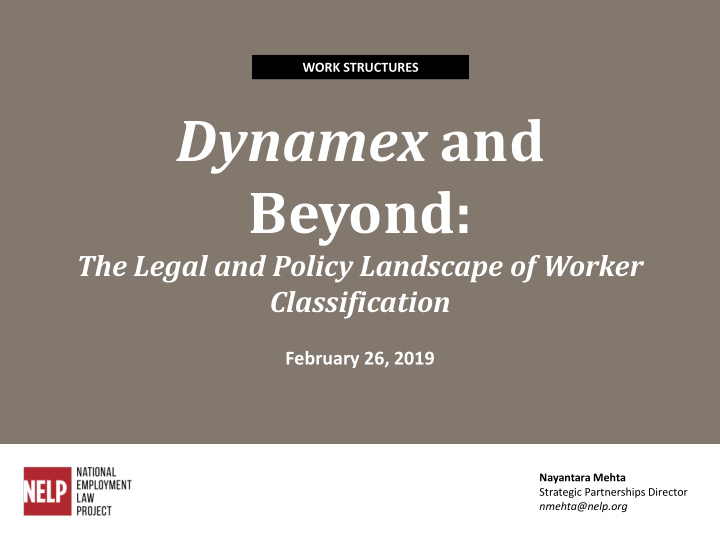



WORK STRUCTURES Dynamex and Beyond: The Legal and Policy Landscape of Worker Classification February 26, 2019 Nayantara Mehta Strategic Partnerships Director nmehta@nelp.org
Agenda What is “misclassification” and who does it affect? What are the consequences of being misclassified for workers? What are the costs of misclassification to the government and the economy? How are legislatures, agencies, and the courts responding, and how does the Dynamex decision and the “ABC test” address the problem?
What is misclassification? Misclassification can take several forms: Employers call employees “independent contractors,” even when the workers are not running their own businesses; Employers require employees to form a limited liability corporation or franchise company-of-one as a condition of getting a job; Employers pay workers off the books, without any payroll treatment at all. Workers are sometimes required to sign boilerplate contracts attesting to independent contractor status, even where the functional relationships do not reflect true independence. Source: NELP Fact Sheet “Independent Contractor Misclassification Imposes Huge Costs on Workers and Federal and State Treasuries,” https://www.nelp.org/publication/independent-contractor-misclassification- imposes-huge-costs-on-workers-and-federal-and-state-treasuries-update-2017/
Why does misclassification matter? Employers in an increasing number of industries misclassify their employees as independent contractors. This practice: Denies workers the protection of workplace laws Deprives Social Security, Medicare, unemployment insurance, and workers’ compensation funds of billions of dollars Reduces federal, state and local tax revenues BUT Saves those who misclassify as much as 30% of payroll and related taxes otherwise paid for “employees.” Source: NELP Fact Sheet “Independent Contractor Misclassification Imposes Huge Costs on Workers and Federal and State Treasuries,” https://www.nelp.org/publication/independent-contractor-misclassification- imposes-huge-costs-on-workers-and-federal-and-state-treasuries-update-2017/
Who does misclassification affect? Employee misclassification is a persistent problem in many of our economy’s growth industries, including: Home care Janitorial Trucking Construction Hospitality Security The rapidly-growing app- based “on - demand” economy Source: NELP Fact Sheet “Independent Contractor Misclassification Imposes Huge Costs on Workers and Federal and State Treasuries,” https://www.nelp.org/publication/independent-contractor-misclassification- imposes-huge-costs-on-workers-and-federal-and-state-treasuries-update-2017/
Who does misclassification affect? Source: UC Berkeley Labor Center report “What Do We Know About Gig Work in California? An Analysis of Independent Contracting,” http://laborcenter.berkeley.edu/what-do-we-know-about-gig-work-in-california/
Consequences for workers Misclassification depresses workers’ income, deprives them of essential workplace protections and social insurance benefits Source: NELP Policy Brief “Independent Contractor vs Employee: Why Misclassification Matters and What We Can Do To Stop It,” https://www.nelp.org/publication/independent-contractor-vs-employee/.
Consequences for workers Misclassification depresses workers’ income, deprives them of essential workplace protections and social insurance benefits Source: NELP Policy Brief “Independent Contractor vs Employee: Why Misclassification Matters and What We Can Do To Stop It,” https://www.nelp.org/publication/independent-contractor-vs-employee/.
Costs to the government: National A 2009 report by the U.S. Government Accountability Office estimated independent contractor misclassification cost federal revenues $2.72 billion in 2006. A 2000 study commissioned by the U.S. Department of Labor found that between 10% and 30% of audited employers misclassified workers. Researchers found that misclassifying just 1% of workers as independent contractors annually results in a $198 million hit to unemployment insurance (UI) trust funds. Source: NELP Fact Sheet “Independent Contractor Misclassification Imposes Huge Costs on Workers and Federal and State Treasuries,” https://www.nelp.org/publication/independent-contractor-misclassification- imposes-huge-costs-on-workers-and-federal-and-state-treasuries-update-2017/
Costs to the government: California In 2017, California’s Employment Development Department Tax Audit Program conducted 7,937 audits and investigations, resulting in assessments totaling $249,981,712 , and identified 461,279 unreported employees . The Division of Labor Standards Enforcement website notes that misclassification costs the state $7 billion annually. Source: 1. EDD 2018 Annual Report on Fraud Deterrence and Detection Activities, https://edd.ca.gov/About_EDD/pdf/Fraud_Deterrence_and_Detection_Activities_20 18.pdf 2. DLSE website, https://www.dir.ca.gov/dlse/worker_misclassification.html
Passing on costs to other businesses Employers who correctly classify workers are at a competitive disadvantage because their misclassifying counterparts have artificially low labor costs. A 2010 study estimated that misclassifying employers shift $831.4 million in unemployment insurance taxes and $2.54 billion in workers’ compensation premiums to law -abiding businesses annually. Source: NELP Policy Brief “Independent Contractor vs Employee: Why Misclassification Matters and What We Can Do To Stop It,” https://www.nelp.org/publication/independent-contractor-vs-employee/.
What are legislatures, agencies and courts doing? Source: NELP Policy Brief “Independent Contractor vs Employee: Why Misclassification Matters and What We Can Do To Stop It,” https://www.nelp.org/publication/independent-contractor-vs-employee/.
The 2018 Dynamex decision “[W]e conclude that unless the hiring entity establishes (A) that the worker is free from the control and direction of the hiring entity in connection with the performance of the work, both under the contract for the performance of the work and in fact, (B) that the worker performs work that is outside the usual course of the hiring entity’s business, and (C) that the worker is customarily engaged in an independently established trade, occupation, or business , the worker should be considered an employee and the hiring business an employer under the suffer or permit to work standard in wage orders.”
More than half of states use an ABC test
More than half of states use an ABC test Given what employee status confers, a simple ABC test, which creates a presumption of employee status, is an effective way to combat misclassification: It is harder for employers to manipulate It is easier for workers to understand It would lead to more predictable outcomes A person’s rights on the job and ability to access our most basic social insurance programs should not depend on their employer’s preference to save costs.
What’s happening around the world?
Resources National Employment Law Project Nayantara Mehta, Strategic Partnerships Director, nmehta@nelp.org Policy Brief: https://www.nelp.org/publication/independent-contractor- vs-employee/ Fact Sheet: https://www.nelp.org/publication/independent-contractor- misclassification-imposes-huge-costs-on-workers-and- federal-and-state-treasuries-update-2017/
Thank You Connect with NELP online:
Recommend
More recommend